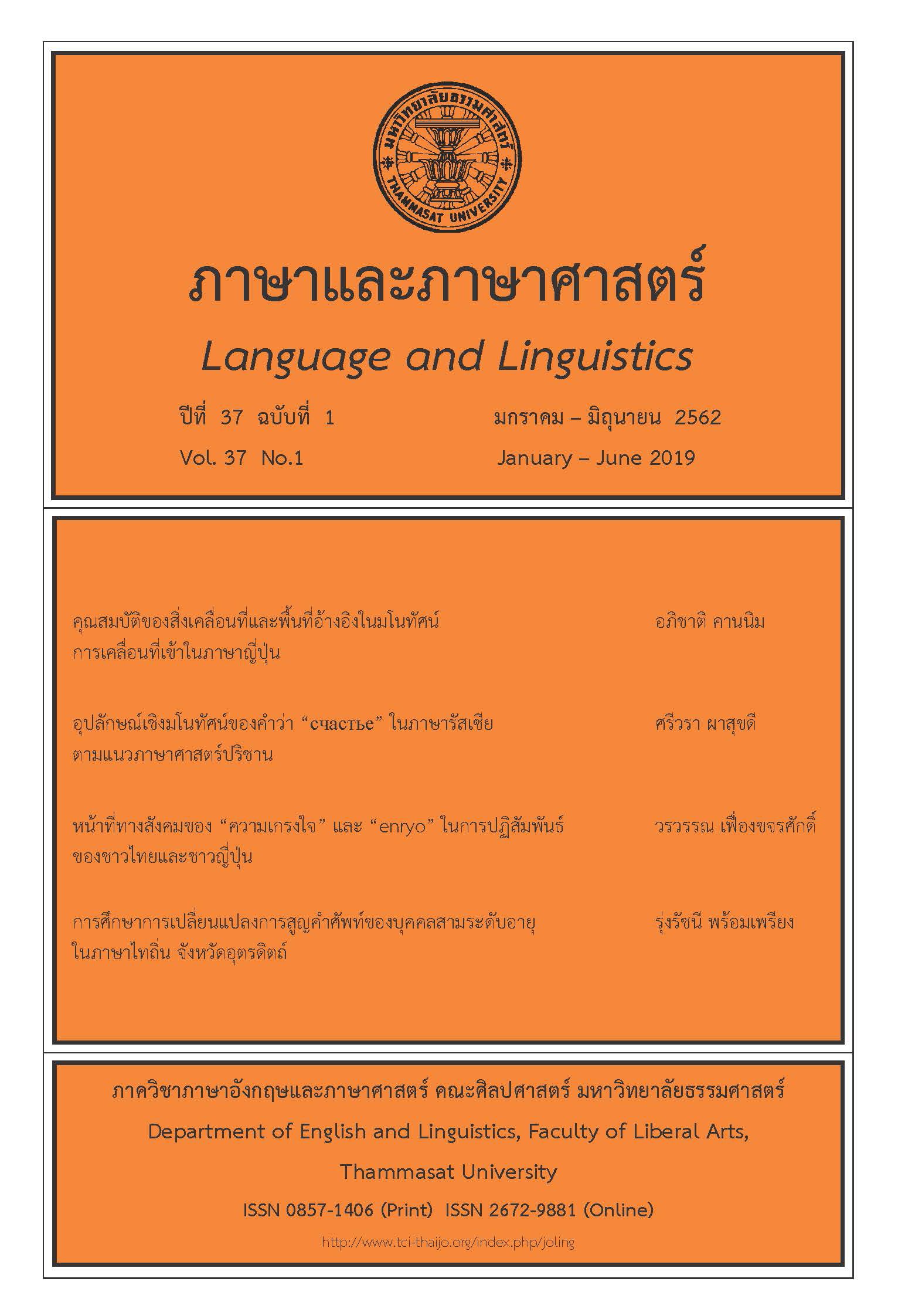The The Social Functions of “khwam kreng jai” and “enryo” in Thai and Japanese Interactions
Main Article Content
Abstract
It is evidently well-known among those who are familiar with Japanese society that there is the concept called “enryo” which is compatible with the “khwam krengjai” value in Thai society. The use of the verbs “kreng jai” and “enryo suru” also seen in a conversation with a person whom a speaker has such value with. The aim of this paper is to compare the social functions of “khwam krengjai” and “enryo” in Thai and Japanese context, focusing on the uses of the verb “krengjai” and “enryo suru”. By relying on the principles of politeness called “Grand Strategy of Politeness” and the cost-benefit of the speaker / hearer, the functions of “khwam krengjai” are divided into four aspects: 1) to show the speaker’s desire for autonomy 2) to show concern to the hearer 3) to encourage the hearer to invite the speaker again 4) to create a good image for the speaker. Among these four functions, there is only the first function which corresponds to the function of "enryo" in Japanese. This reflects that even in both Thai society and Japanese society, the concept of “khwam krengjai” is the same. However, the uses of the verb “kreng jai” and "enryo suru" in the interactions between the speaker and the hearer is different.
Article Details
บทความทุกบทความเป็นลิขสิทธิ์ของภาษาและภาษาศาสตร์
References
Brown, P., & Levinson, S. C. (1987). Politeness: Some universals in language usage. Cambridge, England: Cambridge University Press.
Doi, T. (1986). ‘Amae’: A key concept for understanding Japanese personality structure. In T. S. Lebra & W. P. Lebra (Eds.), Japanese culture and behavior: Selected readings (Revised ed., pp. 121-129). Honolulu, HI: University of Hawaii Press.
Hanks, W., Ide, S., & Katagiri, Y. (2009). Introduction: Towards an emancipatory pragmatics. Journal of Pragmatics, 41(1), 1-9.
Hofstede, G. (2011). Dimensionalizing cultures: The Hofstede model in context. Online Readings in Psychology and Culture, 2(1). https://dx.doi.org/10.9707/2307-0919.1014
Intachakra, S. (2012). Politeness motivated by the ‘heart’ and ‘binary rationality’ in Thai culture. Journal of Pragmatics, 44(5), 619-635.
Isaacs, E. A., & Clark, H. H. (1990). Ostensible invitations. Language in Society, 19(4), 493-509.
Ishii, S. (1984). Enryo-Sasshi communication: A key to understanding Japanese interpersonal relations. Cross-Currents, 11(1), 49-58.
Klausner, W. J. (2002). Thai culture in transition. Bangkok, Thailand: The Siam Society.
Komin, S. (1991). Psychology of the Thai people: Values and behavioral patterns. Bangkok, Thailand: Research Center, National Institute of Development Administration.
Koyama, S., & Ikeda, Y. (2011). Enryo-Sasshi komyunikeshon no sakusei: Yobi chousa ni yoru shakudo no kaitei. Ibunka Komyunikeshon kenkyu, 23, 21-46.
Kubo, S. (2005a). On Japanese speech act enryo: An analysis of an X-sociative and X-regulative speech act. Proceedings of the 10th Conference of Pan-Pacific Association of Applied Linguistics, Tokyo, pp. 139–149.
. (2005b). Gengokoui kara mita raporumanejimento: ‘enryo’ to iu gengokoui. Matsuyama Daigaku Ronshuu, 17(2), 161-191.
Lebra, T. S. (1993). Culture, self, and communication in Japan and the United States. In W. B. Gudykunst (Ed.), Communication in Japan and the United States (pp. 51-87). Albany, NY: State University of New York Press.
Leech, G. N. (1983). Principles of pragmatics. London, England: Longman.
. (2007). Politeness: Is there an East-West divide? Journal of Politeness Research, 3(2), 167-206.
. (2014). The pragmatics of politeness. Oxford, England: Oxford University Press.
Matsuyama, O. (1998). Tainichi nittai kanyaku taigo jiten. Tokyo, Japan: Daigaku shorin.
Maynard, S. K. (1993). Discourse modality: Subjectivity, emotion and voice in the Japanese language. Philadelphia, PA: John Benjamins.
Miike, Y. (2003). Japanese enryo-sasshi communication and the psychology of amae: Reconsideration and reconceptualization. Keio Communication Review, 25, 93-115.
Mole, R. L. (1973). Thai values and behavior patterns. Tokyo, Japan: Charles E. Tuttle.
Ohashi, J. (2008). Linguistic rituals for thanking in Japanese: Balancing obligations. Journal of Pragmatics, 40(12), 2150-2174.
Spencer-Oatey, H., & Franklin, P. (2009). Intercultural interaction: A multidisciplinary approach to intercultural communication. New York, NY: Palgrave Macmillan.
Takei, I., & Alston, J. P. (2018). Japanese Business Culture and Practices. Bloomington, IN: iUniverse.
Takita, F. (2012). Reconsidering the concept of negative politeness ‘enryo’ in Japan. Hiroshima Studies in Language and Language Education, 15, 189-196.
Ukosakul, M. (2005). The significant of ‘face’ and politeness in social interaction as revealed through Thai ‘face’ idioms. In R. T. Lakoff & S. Ide (Eds.), Broadening the horizon of linguistic politeness (pp. 117-128). Amsterdam, The Netherlands: John Benjamins.
Wierzbicka, A. (1997). Understanding cultures through their key words. Oxford, England: Oxford University Press.

